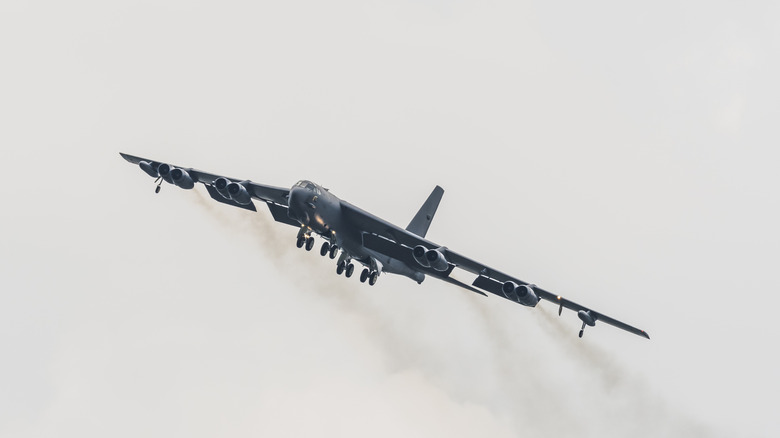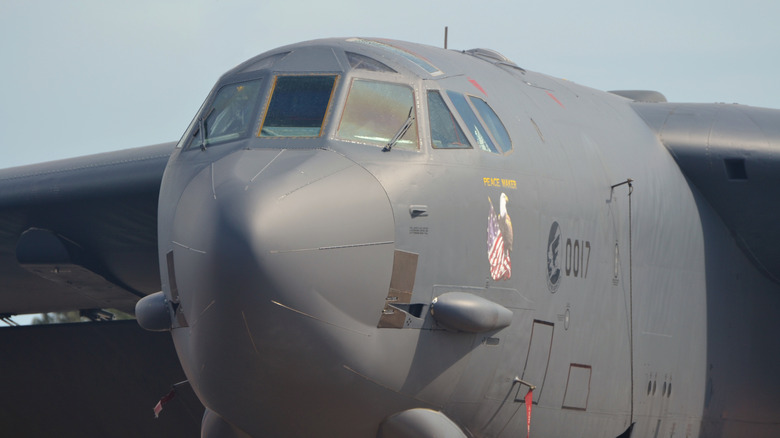Why Does The B-52 Bomber Have Wheels On Its Wings?
Looking up in the sky at any fixed-wing aircraft in flight, and if it's low enough, you typically see the outlines of a fuselage and two wings. If you're viewing a standard airplane with a normal configuration, the landing gear is either fixed or retracted below the belly of the plane. Not so in the case of the legendary Boeing B-52 Stratofortress, an iconic American bomber that has served the Air Force for over 70 years now. These massive airplanes curiously have wheels fixed on their wings, visible to the naked eye. While it is likely a rare sight in the skies over most American cities, there remain 76 B-52s currently in service as part of the US Air Force's long-range bomber fleet.
The B-52 has obviously had many upgrades since it was first introduced to keep it modernized and functional, still ready for war. And if properly maintained, it is thought that these bombers could remain in service until the 2050s, which would at that point make them 100-year-old workhorses — hard to believe. But many military plane enthusiasts have wondered over the years exactly why a B-52 comes equipped with fixed landing gear on the outer edges of its wings. Here, we will explore the practical engineering choices that went into this unique design which led to having wheels on the wings, and how they're meant to function.
The B-52 is an engineering marvel
To support the weight of its massive 185-foot wingspan, holding onto eight turbojet engines, with an eye-watering overall weight of 185,000 pounds, a B-52 has outrigger wheels under each wingtip. They are referred to as wingtip landing gear, which are different from the main landing gears. When fully loaded with fuel, each wing can flex downwards by as much as 12 feet, potentially hitting the ground when the plane's axis pitches during takeoff or landing. To prevent damage to the wings, engineers opted to bolster the wing support with these outrigger wheels, preventing the outer wings from scraping runways. This accounts for the natural wing droop which was built into the bomber's design, allowing it to carry a heavy payload — upwards of 70,000 pounds of mixed ordnance — during warfare.
The name of the type of landing gear configuration seen on a B-52 is colloquially referred to as a "bicycle arrangement," which means it has two sets of wheels stacked in a line under the fuselage, unlike most planes, which have a "tricycle" type arrangement. The B-52 landing gear is not dissimilar to that of the B-47 bomber, using four two-wheel bogies. In the case of the Stratofortress, to combat crosswinds, its landing gear can actually be adjusted to angles up to 20 degrees to either side when descending towards a runway.
How the B-52 manages safe landings
In heavy crosswinds, many airplanes can do what's referred to as the "crab landing method," which means a plane's nose is pointed into the wind to help maintain proper course to the runway, while it moves forward tilted on a slight angle laterally. Pilots then use the rudder to correct the flight path right before the moment of touchdown, to straighten out the plane. But due to the huge wingspan of the B-52 bomber, and the fact that it is slow to respond at low speeds, it cannot be adjusted in mid-air. Thanks to clever engineering, the plane's 20-degree adjustable landing gears and outrigger wheels allow it to crab safely and land on an angle amidst brutal wind. While there are many anecdotes of those outer wing wheels inadvertently hitting lights on narrow runways, they keep B-52 wings protected while under massive stress and flex.
In spite of the myriad technological advances since the B-52 was developed in the 1950s — like that of the stealth B-2 bomber — it remains a stalwart long-range bomber for the U.S. military, and one that seems irreplaceable, at least for now. Sure, it's long in the tooth, but some designs simply pass the test of time and remain relevant, ready for service should the need arise. Next time you see a B-52 in the sky, hopefully you'll have a newfound appreciation for these "Stratofortresses" and those odd but useful wheels on its wings.


